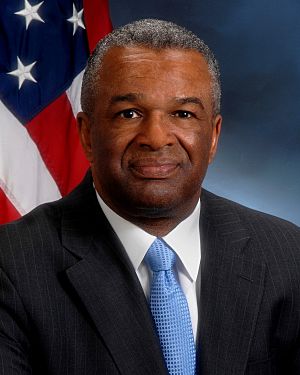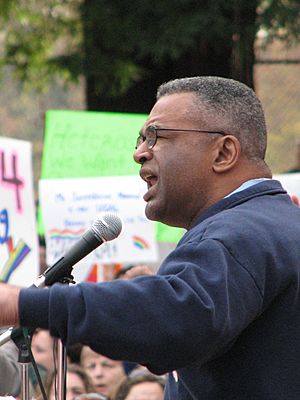Ron Sims facts for kids
Quick facts for kids
Ron Sims
|
|
|---|---|
 |
|
| 7th United States Deputy Secretary of Housing and Urban Development | |
| In office May 8, 2009 – July 31, 2011 |
|
| President | Barack Obama |
| Preceded by | Roy Bernardi |
| Succeeded by | Maurice Jones |
| 6th King County Executive | |
| In office January 15, 1997 – May 8, 2009 |
|
| Preceded by | Gary Locke |
| Succeeded by | Kurt Triplett (acting) |
| Member of the King County Council from the 5th district |
|
| In office January 1, 1986 – January 15, 1997 |
|
| Preceded by | Ruby Chow |
| Succeeded by | Dwight Pelz |
| Personal details | |
| Born |
Ronald Cordell Sims
July 5, 1948 Spokane, Washington, U.S. |
| Political party | Democratic |
| Spouse | Cayan Topacio |
| Children | 3 |
| Education | Central Washington University (BA) |
Ronald Cordell Sims, born on July 5, 1948, is an important American leader who has held several big jobs in government. He was the Deputy Secretary for the United States Department of Housing and Urban Development (HUD) from 2009 to 2011. Before that, he was the King County Executive in Washington state. Sims also tried to become a U.S. Senator in 1994 and the governor of Washington in 2004, but he didn't win those elections.
Contents
Early Life and Education
Ron Sims was born in Spokane, Washington. His parents were Reverend James C. Sims Sr. and Lydia T. Sims. He went to Lewis and Clark High School. After high school, he studied at Central Washington University in Ellensburg. He earned a bachelor's degree in psychology.
Before starting his political career, Sims worked in different roles. He worked for the Washington State Attorney General's office. He also worked for the Federal Trade Commission. He helped with a program for young offenders in Seattle. He even worked as an assistant in the state senate. Ron Sims is also an ordained Baptist minister.
Ron Sims' Political Journey
Ron Sims began his political career in 1985. He was elected to the King County Council. He was re-elected two more times, in 1989 and 1993. During his first time on the council, he helped change the name of King County. In 1986, the county was officially renamed to honor Martin Luther King Jr.. Before that, it was named after William R. King, who had owned slaves. The state of Washington made this name change legal in 2005.
In 1994, Sims ran for the United States Senate. He was a Democrat. However, he lost to the Republican leader, Slade Gorton.
Becoming King County Executive
In 1996, Ron Sims was chosen to be the King County Executive. This happened after the previous executive, Gary Locke, became the governor of Washington. Sims was very popular in this role. He was re-elected three times: in 1997, 2001, and 2005.
In 2003, he announced he wanted to become the governor of Washington. He suggested a new tax plan. He wanted to replace the state's sales tax with an income tax that would be different for people with different incomes. In the election held in September 2004, Sims lost to Christine Gregoire.
Working for the U.S. Government
On February 2, 2009, President Barack Obama chose Ron Sims for a big job. He nominated Sims to be the Deputy Secretary of the U.S. Department of Housing and Urban Development (HUD). The United States Senate approved his nomination on May 6, 2009. He officially started his new job on May 8, 2009.
Sims worked at HUD for a little over two years. On June 14, 2011, he announced he would be leaving his job. He said he wanted to spend more time with his family back in Seattle.
Important Issues in King County
During his time as King County Executive, Ron Sims dealt with several important local issues.
Brightwater Sewage Plant
One big project was the Brightwater sewage treatment plant. It was built by King County in a nearby county called Snohomish County. This project had some problems. There was a lawsuit between the counties about how to handle the plant's effects. The plant also cost more money than planned. People were also worried because it was built near earthquake fault lines.
Tent City 4
In 2004, Sims suggested letting a tent city (a place where homeless people live in tents) stay temporarily on county land. This plan faced a lot of opposition. People who didn't like the idea filed a lawsuit, and the plan was stopped. Later, the county council decided to put a one-year ban on homeless camps on public land. This ban is still in place today.
Protecting Natural Areas
In 2004, the King County Council passed a rule called the Critical Area Ordinance (CAO). This rule was made to protect important natural areas. These areas include wetlands and streams. It also limited building in dangerous places like floodplains and steep slopes where landslides could happen. This rule caused some debate. Some landowners felt it limited what they could do with their property.
Rails to Trails Plan
In 2005, Sims announced a plan to buy a railroad line. This line was about 47 miles long and ran through east King County. His idea was to remove most of the tracks and turn the area into a bicycle trail. This plan was controversial. Some people wanted to keep the railroad tracks for trains. They thought the tracks could be used for public transportation or for the popular Spirit of Washington dinner train.
Boeing Field Airlines Proposal
In 2005, Southwest Airlines wanted to move some of its flights from Sea-Tac Airport to Boeing Field. They planned to build a new passenger terminal there. Alaska Airlines also showed interest in a similar move. However, many people living near Boeing Field, as well as local leaders, were against these plans. They worried about more noise and traffic. After hearing these concerns, Sims decided not to approve the proposals. He said the area couldn't handle both airlines without major road improvements.
Personal Life
Ron Sims and his wife, Cayan Topacio, live in the Mount Baker neighborhood of Seattle. They have three sons named Douglas, Daniel, and Aaron.
See also
- List of African-American United States Senate candidates


